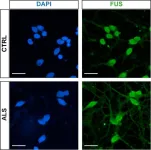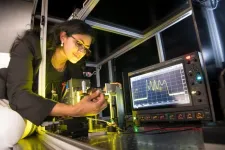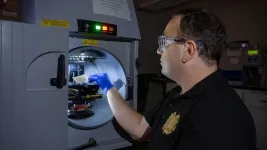Research reveals the scale of disorder underpinning Motor Neurone Disease
2023-07-21
(Press-News.org) Francis Crick Institute press release
Under strict embargo: 16:00hrs BST 21 July 2023
Peer reviewed
Experimental study
Cells
Research reveals the scale of disorder underpinning Motor Neurone Disease
Researchers at the Francis Crick Institute and UCL have shown that hundreds of proteins and mRNA molecules are found in the wrong place in nerve cells affected by Motor Neuron Disease (MND), also known as Amyotrophic Lateral Sclerosis (ALS).
ALS is a rapidly progressing and devastating condition that causes paralysis by affecting motor neurons, with limited treatment options. Until now, scientists were aware that a few proteins, especially a protein called TDP-43, were found in unexpected locations in ALS nerve cells.
But new research published today in Neuron shows that the problem is much broader. This ‘mislocalisation’ affects many more proteins than first thought, especially those involved in RNA binding. The mislocalisation extends to mRNAs too, molecules that deliver instructions to make proteins from the DNA in the nucleus.
The researchers used stem cells from patients to create motor neurons with ALS-causing mutations in the TARDBP and VCP genes. They then separated the two main compartments of the cell (nucleus and cytoplasm), and analysed all the mRNA and protein within each. They found that in ALS cells, hundreds of mRNAs and proteins were mislocated compared to healthy cells.
They observed proteins and mRNAs relocating from the cell’s nucleus (the ‘control centre’) into the cytoplasm (the ‘body’ of the cell) or vice versa, hinting at potential transport issues within the cell.
The researchers also saw that mislocated mRNAs and proteins interacted more with each other, compared to those in the right place. They speculate that as the mRNAs and proteins mislocalise, they may drag each other with them, creating a domino effect.
Oliver Ziff, Clinician Scientist at the Crick and UCLH, said: “We were surprised to see the extent of the mislocalisation, particularly for mRNAs, as this hasn’t been reported before. The goal now is to find where this problem starts and there are many intriguing possibilities – one being a breakdown in the transport between the nucleus and cytoplasm. This study was an exceptional team effort, and I’m immensely grateful to my colleagues, particularly co-first authors, Drs Jasmine Harley, Yiran Wang, and Jacob Neeves”.
Remarkably, the mislocalisation of proteins and mRNAs was partially improved with a drug called ML240, which blocks the action of the VCP enzyme. Blocking this enzyme also led to other beneficial effects on cell function, such as reducing the level of damage to DNA.
Rickie Patani, Senior Group Leader of the Human Stem Cells and Neurodegeneration Laboratory at the Crick, Professor at UCL and Consultant Neurologist at the National Hospital for Neurology, said: “For the patients I see, it’s devastating that there aren’t yet impactful treatments available for ALS. This research represents a shift in our thinking about what causes ALS – it doesn’t involve abnormal movement of just a few proteins, but the abnormal localisation of hundreds of proteins and mRNAs. This opens new avenues for research and potential therapies.
“As ML240 improved the mislocalisation and other disease features in ALS, we now need to understand if this can be a tractable therapy for ALS more widely. This is just the beginning and there is lots more to do, but our work provides some hope for effective therapies.”
The researchers will next investigate protein and mRNA location in other ALS genetic backgrounds. There is also much more work ahead before VCP inhibitors could be used clinically – ML240 hasn’t yet been tested in animals, and potential chemical changes may be necessary to make sure it enters nerve cells without causing side effects.
-ENDS-
For further information, contact: press@crick.ac.uk or +44 (0)20 3796 5252
Notes to Editors
Reference: Ziff, O. et al. (2023). Nucleocytoplasmic mRNA redistribution accompanies RNA binding protein mislocalisation in ALS motor neurons and is restored by VCP ATPase inhibition. Neuron. https://doi.org/10.1016/j.neuron.2023.06.019.
The Francis Crick Institute is a biomedical discovery institute dedicated to understanding the fundamental biology underlying health and disease. Its work is helping to understand why disease develops and to translate discoveries into new ways to prevent, diagnose and treat illnesses such as cancer, heart disease, stroke, infections, and neurodegenerative diseases.
An independent organisation, its founding partners are the Medical Research Council (MRC), Cancer Research UK, Wellcome, UCL (University College London), Imperial College London and King’s College London.
The Crick was formed in 2015, and in 2016 it moved into a brand new state-of-the-art building in central London which brings together 1500 scientists and support staff working collaboratively across disciplines, making it the biggest biomedical research facility under a single roof in Europe.
http://crick.ac.uk/
END
[Attachments] See images for this press release:

ELSE PRESS RELEASES FROM THIS DATE:
2023-07-21
LA JOLLA, CA — Scripps Research scientists have developed a machine-learning system—a type of artificial intelligence (AI) application—that can track the detailed evolution of epidemic viruses and predict the emergence of viral variants with important new properties.
In a paper in Cell Patterns on July 21, 2023, the scientists demonstrated the system by using data on recorded SARS-CoV-2 variants and COVID-19 mortality rates. They showed that the system could have predicted the emergence of new SARS-CoV-2 “variants of concern” (VOCs) ahead of their official designations by the World Health Organization (WHO). Their ...
2023-07-21
Researchers from the University of Liverpool have created a biomedical compound that has the potential to stop the spread of breast cancer. A recently published paper details these early findings.
Scientists from the Chemistry and Biochemistry Departments at the University of Liverpool and Nanjing Medical School in China have discovered a possible way to block proteins produced in the body when a patient has cancer and which causes its spread to other parts of the body. This process, called metastasis, is largely responsible for patient deaths.
The major problem hindering the successful treatment of commonly occurring cancers is not the primary tumour which can usually be removed by ...
2023-07-21
Male crickets sing in unison to attract females – but stop singing if a rival gets too close, new research shows.
University of Exeter scientists watched more than 100 male field crickets, and measured how often they chirped at the same time (called “singing overlap”).
Singing by males one to five metres away from a listening male had a “stimulatory effect”, leading to a chorus of crickets singing together.
However, males were less likely to sing if another cricket chirped within one metre – possibly because the territorial insects instead chose to fight ...
2023-07-21
Some people’s brain function still affected by Long COVID years after infection
UK researchers have found that people with longer-term COVID-19 symptoms including brain fog showed reduced performance in tasks testing different mental processes up to two years after infection with the virus.
Researchers from King’s College London looked at whether infection with COVID-19 affected performance in two rounds of online cognitive testing that took place in 2021 and 2022. Data was collected for over 3,000 participants of the COVID Symptom Study Biobank study, across 12 tasks that tested memory, attention, reasoning, processing speed and ...
2023-07-21
A scientist from Northumbria University has been awarded almost half a million pounds to develop a new technology which could transform deep-space communication, radio astronomy, medical imaging and airport security scanning.
Dr Juna Sathian has received a grant from the government’s Engineering & Physical Sciences Research Council (EPSRC) to develop a new type of MASER (Microwave Amplification by Stimulated Emission of Radiation) device.
The forerunner to LASERs, MASERs were first discovered in the 1950s. But there has been ...
2023-07-21
Benjamin Franklin may be best known as the creator of bifocals and the lightning rod, but a group of University of Notre Dame researchers suggest he should also be known for his innovative ways of making (literal) money.
During his career, Franklin printed nearly 2,500,000 money notes for the American Colonies using what the researchers have identified as highly original techniques, as reported in a study published this week in the Proceedings of the National Academy of Sciences.
The research team, led by Khachatur Manukyan, an associate research professor ...
2023-07-21
Researchers at Baylor College of Medicine and collaborating institutions are developing a strategy to predict the response of triple negative breast cancer (TNBC) to chemotherapy, which would be a valuable tool for physicians deciding on the treatment with better probability of success on an individual basis. The study appears in Cancer Research Communications, a journal of the American Association for Cancer Research.
“Multiple research innovations in cancer diagnostics are on display in this work,” said co-corresponding author Dr. Matthew Ellis, member of the Lester and Sue Smith Breast Center and the Dan ...
2023-07-21
NEWPORT NEWS, VA – Peter Hurck has been searching for strange particles, named such because they contain strange quarks, since beginning work on his Ph.D. As the 2023 Jefferson Science Associates (JSA) Postdoctoral Prize winner, he’ll continue conducting data analyses to identify strange particles and learn about their properties.
Many of these experiments that contribute to the data Hurck is analyzing are conducted at the U.S. Department of Energy's Thomas Jefferson National Accelerator Facility, which is managed and operated by JSA.
“Strangeness hasn't been studied as much because it's quite ...
2023-07-21
On July 19, the American Society for Biochemistry and Molecular Biology released a statement expressing concerns on the National Institutes of Health budget proposed in the House Labor, Health and Human Services, Education and Related Agencies funding bill. The bill allocates only $44.7 billion for NIH, which represents a 6.4% decrease from fiscal year 2023 levels and would have detrimental repercussions for the National Institute of Allergy and Infectious Diseases, the National Institute of Neurological Diseases and Stroke, the National Cancer Institute and the National Institute ...
2023-07-21
Microparticle dust aggregates, which are thought to play a role in the formation of new planets, are less likely to stick together after a collision when the aggregates are larger.
Current evidence suggests that microparticles of cosmic dust collide and stick together to form larger dust aggregates that may eventually combine and develop into planets. Numerical models that accurately characterize the conditions required for colliding microparticle aggregates to stick together, rather than bounce apart, are therefore ...
LAST 30 PRESS RELEASES:
[Press-News.org] Research reveals the scale of disorder underpinning Motor Neurone Disease




